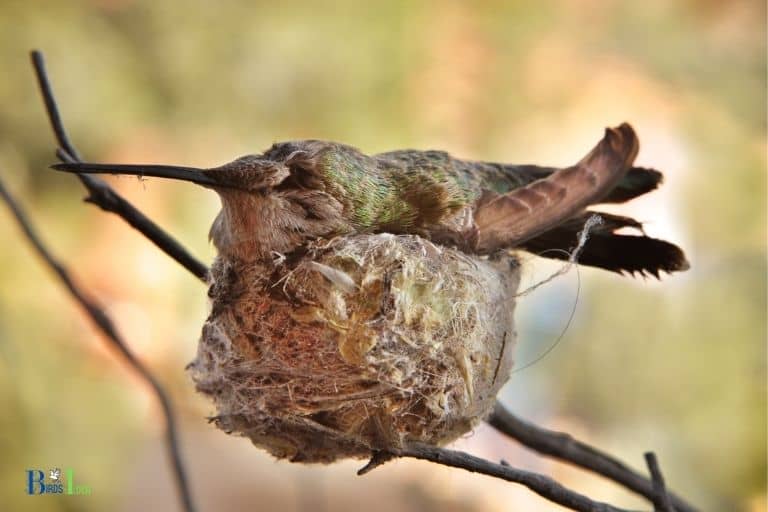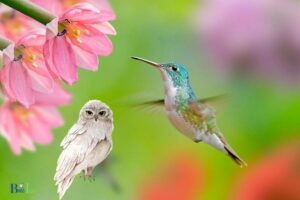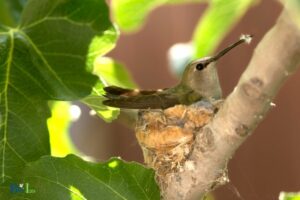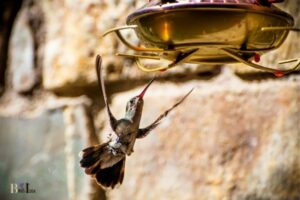Do Hummingbird Families Stay Together? No!
No, hummingbird families do not stay together for a long time, as they follow a solitary lifestyle after a short period of parental care.
Hummingbirds are known for their solitary behavior and do not form long-lasting family bonds.
After the mating process, the male hummingbird plays no role in raising the offspring, leaving the female to take care of the eggs and young ones. Once the young birds become independent and learn to fly, they too follow a solitary lifestyle.
In summary, hummingbird families do not stay together due to their solitary nature. After mating, the responsibility of raising the offspring falls entirely on the female.
Once the young ones become self-sufficient, they leave their mother’s nest to live independently, embracing the solitary lifestyle of their parents.
This lack of strong family bonds is a unique characteristic of hummingbirds, making them different from many other bird species.
8 Aspects: Hummingbird Families Stay Together
| Family Aspect | Description |
|---|---|
| Mating | Hummingbirds are primarily solitary creatures, and typically only come together briefly for mating purposes. |
| Nesting | The female builds the nest, incubates the eggs, and takes care of the chicks on her own, without assistance from the male. |
| Offspring Care | Once the chicks are hatched, the mother is responsible for their care and feeding, while the father may likely have moved on to mate with another female. |
| Migration | Hummingbirds do not migrate as a family group; each individual is on their own during migration periods. |
| Territory | Males defend their territories from other males, and females establish their own feeding territories. Families do not share territories together. |
| Social Interaction | Hummingbirds generally have minimal social interactions with one another, except during mating season or at food sources, such as a feeder. |
Key Takeaway

Five Facts About Hummingbird Families
Do Hummingbird Families Stay Together Naturally?
Categorize Hummingbirds As Solitary Or Social Animals
Hummingbirds are unique birds known for their rapid wing motion and their ability to flutter in mid-air. They are mainly known to be solitary creatures, but some species have developed social behaviors.
Hummingbirds can be categorized as solitary or social animals based on their typical behaviors and patterns.
Explanation That Hummingbirds Aren’T Inherently Social Animals
Unlike other birds, hummingbirds are solitary creatures by nature. They only interact with others of their species for the sole purpose of reproduction. This means that they do not form any social bonds with other hummingbirds.
Elaboration On The Typical Behaviors And Patterns Of Social Animals
Social animals depend on their group members for survival and exhibit some particular behaviors such as communication, sharing resources, and cooperation.
On the other hand, hummingbirds typically fend for themselves and are not known to engage in social behaviors unless it’s for reproduction.
Here are some typical behaviors of social animals which are absent in hummingbirds:
- Communication: Social animals use various forms of communication such as sounds, touch, and scent to communicate with their group members. Hummingbirds, on the other hand, have no verbal communication and do not engage in physical contact with other hummingbirds outside reproduction.
- Sharing resources: Social animals tend to share resources like food and shelter for the betterment of the group. Hummingbirds, however, are territorial birds and will defend their feeding grounds from other hummingbirds.
- Cooperation: Social animals exhibit cooperative behavior and work together for the survival of the group. Hummingbirds are mainly solitary creatures, so cooperation between them is limited.
Hummingbirds are mainly solitary birds and do not exhibit the typical behaviors of social animals. While some hummingbird species may exhibit social behaviors while breeding, they are not inherently social creatures by nature.
Hummingbird Family Dynamics
Brief Overview Of Hummingbird Mating And Nesting Behaviors
Hummingbirds have unique reproductive behaviours, including elaborate aerial dances to attract mates. Once they have found a mate, these birds work together to build a nest.
The tiny nest usually contains two eggs, roughly the size of navy beans, which will take about two to three weeks to hatch.
The chicks will grow quickly and fledge within two to three weeks.
Explanation That Hummingbirds Stick Together During Mating Season And Rearing Young
Hummingbirds have a strong bond and usually stay together through the mating season. They exhibit courtship behaviours such as aerial displays and flight songs before mating.
Once the eggs are laid, both parents will take turns incubating the eggs and feeding the chicks.
They also fiercely defend their nests against predators.
Detail On How Hummingbirds Share Reproduction Duties
Both males and females participate in raising hummingbird chicks. The mother hummingbird lays eggs, incubates them, and feeds the chicks. The father hummingbird assists with feeding and contributes to the incubation of the eggs.
After hatching, both parents are involved in feeding the chicks and keeping them warm until they can fly on their own.
Elaboration On How Hummingbird Families Communicate With One Another
Hummingbird families communicate primarily through a series of chirps and trills. A mother hummingbird will communicate with her offspring through a variety of sounds, while the father will use specific chirps to signal any potential threats.
Both parents will also use visual cues such as body language to communicate with each other and their chicks. As the chicks grow, they too will begin to communicate with their parents in a variety of ways.
Factors That Affect Hummingbird Family Unity
Hummingbirds are famously known for their vivid colors, their swift movements, and their unique behavior among bird species.
They are also exceptional parents, showing remarkable care and attention to their young ones. But as much as hummingbirds prioritize their family, their unity is not always guaranteed.
In this blog post, we will discuss the factors that affect hummingbird family unity, including climate and weather patterns, predator threats, food and water sources, and social behaviour.
Discussion On The Effect Of Climate And Weather Patterns
Hummingbirds are mostly found in tropical regions, where they thrive in hot and humid weather. However, climate change and extreme weather patterns can negatively impact their breeding and survival rates.
For instance, prolonged droughts can lead to a decrease in nectar production from flowers, affecting the availability of food for hummingbirds.
On the other hand, heavy rainfall can cause flooding, destroying their nests and exposing their eggs and young ones to predators.
- Droughts lead to a decrease in nectar production from flowers, reducing food availability.
- Heavy rainfall can cause flooding, destroying nests and exposing young ones to predators.
Explanation Of The Impact Of Predator Threats
Predator threats can also impact hummingbird family unity by causing stress and even death. Common predators of hummingbirds include snakes, lizards, and even some insect species.
During breeding and nesting periods, hummingbirds are highly territorial and will aggressively defend their nests from predators.
However, the vulnerability of young ones and eggs means that predators can still pose a significant threat to their survival.
- Predator threats can cause stress and even death to hummingbirds.
- Young ones and eggs are especially vulnerable to predator attacks.
Detail On How Food And Water Sources Can Affect Hummingbird Families
Hummingbirds are known for their high metabolic rate, which requires them to consume more than their body weight in food every day. Therefore, the availability of food and water sources is crucial for their survival.
A lack of nectar-producing flowers near their habitat can cause hummingbirds to range longer distances in search of food, making it harder for them to care for their young ones.
- A lack of nectar-producing flowers near their habitat can make it harder to find food.
- Range expansion in search of food makes it harder for hummingbirds to care for their young ones.
Elaboration On How Social Behavior May Be Affected By Breeding Seasons And Migratory Patterns
Hummingbirds exhibit social behavior such as mating, nesting, and territory defense, which can be affected by breeding seasons and migratory patterns.
During breeding seasons, males attract and mate with females, while females are responsible for building nests and raising young ones.
Additionally, some hummingbird species migrate for long distances, affecting their social behavior and family unity.
- Breeding seasons influence social behavior such as mating and nesting.
- Migratory patterns can affect social behavior and family unity.
As we have seen, hummingbird family unity can be influenced by several factors such as climate and weather patterns, predator threats, food and water sources, and social behavior.
Understanding these factors will help conservationists and bird lovers alike to protect these amazing birds and ensure their survival for future generations.
How Can We Help Hummingbird Families Stay Together?
Do Hummingbird Families Stay Together
Hummingbirds are fascinating creatures that are loved by people all over the world. The idea of tiny birds darting around and sipping nectar from flowers is enchanting.
But have you ever wondered if these birds stay together as a family or just live their lives solo?
We will answer that question. We will also explore how we can help hummingbird families stay together.
Explanation On What We Can Do To Provide Adequate Food And Shelter
Hummingbirds need a lot of food to survive, and they need a safe place to rest and roost.
Here are some ways we can help provide for their needs:
- Plant native plants: Planting native plants around your property will provide hummingbirds with a natural food source. Native plants such as indian paintbrush, salvia, and fuchsia are great choices.
- Hang feeders: Hanging hummingbird feeders is an easy way to provide a food source. But remember, commercial nectar should be avoided as it contains preservatives that can harm hummingbirds.
- Keep feeders clean and full: Make sure to clean hummingbird feeders every few days and keep them full of fresh nectar. This will help keep hummingbirds coming back to your yard.
- Provide a water source: Hummingbirds need water for bathing and drinking. A shallow bird bath or misting device will attract them to your yard.
- Create nesting opportunities: Planting shrubs that provide cover or putting up nesting boxes will provide hummingbirds with a safe place to build their nests.
Detail On How To Create A Hummingbird-Friendly Garden
Hummingbirds are attracted to bright colors such as orange, red, and pink.
Here are some tips for creating a hummingbird-friendly garden:
- Choose the right plants: Select plants that produce tubular flowers or flowers with a trumpet shape. Plants such as bee balm, columbine, and cardinal flower are great choices.
- Create dimension: Layering plants of different heights and colors will make your garden more attractive to hummingbirds.
- Provide perches: Hummingbirds need perches to rest and survey their territory. Adding perches can be as simple as putting up a clothesline or installing a shepherd’s hook.
- Eliminate pesticides: Avoid using pesticides as they can be harmful to hummingbirds and their food sources.
- Use hummingbird-friendly fertilizers: Avoid fertilizers that contain chemicals harmful to hummingbirds. Use organic fertilizers instead.
Elaboration On The Importance Of Bird-Friendly Deterrents To Keep Predators Away
Hummingbird families face many predators, such as cats, raccoons, and snakes.
Here are some bird-friendly deterrents that will keep them at bay:
- Install baffles: Installing baffles on feeder poles will keep predators such as raccoons and snakes from climbing up to the feeders.
- Use motion-activated devices: Motion-activated sprinklers or noise makers will scare away predators.
- Keep cats indoors: Keeping cats inside will reduce the number of attacks on hummingbirds in your yard.
By following these guidelines, you can help hummingbirds thrive and stay together as a family. It is important to remember that hummingbirds are essential to our ecosystem.
By providing them with a safe and welcoming environment, we can help ensure their survival for generations to come.
FAQ On Hummingbird Families
Do Hummingbirds Stay With Their Families For Life?
How Do Hummingbirds Raise Their Young?
What Is The Lifespan Of A Hummingbird?
How Can You Attract Hummingbirds To Your Garden?
Conclusion
It’s fascinating to learn that hummingbirds are loyal creatures that stick together as a family. They are known to mate for life, and the female plays a significant role in raising their young ones.
The mother hummingbird lays and incubates the eggs, while the male hums around, protecting the nest and feeding the family.
Once the babies leave the nest, they stay with their parents for a short time to learn survival skills before venturing out. Research has shown that young male hummingbirds tend to disperse, while females tend to stay close to their family.
So, while hummingbird families don’t stay together for an extended period, they still have a bonding and nurturing experience. Knowing this, we can appreciate these little creatures even more and the importance of family in their lives.
Watching hummingbirds in their natural habitat can be an incredible experience, and it’s one we should cherish and protect for generations to come.






